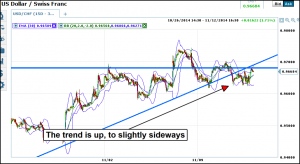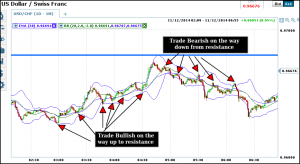My 60 Second Binary Options Strategy
I have been toying around with 60 strategies for a long time. In general I think trading 60 seconds profitably is near impossible but that is what provides a lot of the challenge. That and the fact that trading is just plain challenging by itself. Over the past almost three years I have read a lot of strategies, reviewed a lot of indicators and examined untold numbers of systems. Most of which are completely useless for trading 60 second options simply because the reaction time between the signal and you executing the trade is just to long. I’m not saying that this is a fool proof or 100% guaranteed strategy but I can say that it is by far what I consider to be the best way to trade such short time frames. Basically it is based on volatility and market movement, duh, but specifically on one indicator that manages to capture these two phenomena quite well; Bollinger Bands ™.
Bollinger Bands And 60 Second Trading
This strategy is based on Bollinger Bands but also uses a few other indicators as well. It is not too difficult to master but does require a little experience. Basically, I use the hourly charts to set trend. You can do this in a number of ways but in general you will want to choose a market that is trending fairly strongly in this time frame. You may want to start with a daily chart, look for a good trend, then move down to the hourly chart and begin to look for the trade. I use stochastic, MACD and trend lines to make this assessment. Also, on the daily and especially the hourly chart you will want to draw support/resistance and trend lines as needed. These will help you to pinpoint your entries and also to keep you out of trades with a higher potential for loss. I will include links to other relevant articles at the bottom of this page which will help you fine tune this strategy.
- Daily Chart – Use of this chart can help identify shorter term trends and potential areas of support/resistance. Use candlestick set up, identify trend and confirm with trend lines, MACD, Stochastic or other oscillator. Also draw in potential areas for support and resistance. Draw lines on this chart in BLUE. Trend here can be up, down or sideways.
- Hourly Chart – Identify short term trend and mark with a RED line. Use MACD, stochastic and other oscillators to confirm. If the daily is trending up, only trade the uptrend on the hourly chart. The same if the daily chart trend is down, only trade the downtrend on the hourly chart. If the daily chart is trending sideways, at a peak or trough let the hourly chart be your guide.
- One Minute Chart – On this chart you will only by using the Bollinger Bands. If the trend has been determined as up, only trade bullish signals and vice versa for down trends.

Best Brokers For 60 Second Timeframe
The Signals
Bollinger Bands creates number of signals but the one most important for this strategy is the widening/narrowing of the bands. That is because the widening of the bands signifies market movement and specifically an increase of market movement. When the bands are narrow the asset is not volatile and not moving as much as when the bands are wide. When the bands are wide and/or widening the asset is moving more than it has over the past 20 bars with an expectation of it moving more over the next few bars.
For this strategy the widening of the bars is to be considered the pre-signal. As a 60 second binary trader you only want to trade when the bands are wide and the market is moving. Watch the bands, over time they create a pattern that moves with the underlying asset. When the bands begin to widen after a period of narrow trading it is your signal to watch for signals. At that time you will take entry on any signal that confirms the underlying trend as determined on the hourly charts. This is where experience comes into play. Bollinger Bands give a lot of different signals with no regard to trend so it takes a little bit of personalized interpretation to identify the signals you want. This is why I insist on using trend to weed out at least some of the signals produced; the trend is your friend, trade with your friend.

- When price moves up to touch a band it is usually a signal that the trend will continue on that direction.
- When price exceeds a band it is usually a signal that prices have reached or exceeded an acceptable extreme and are most likely going to pull back.
- Candlestick signals that occur on or at a Bollinger Band are to be considered confirmations of the band.
- Signals that confirm support/resistance or trend at the same time as confirming one of the three Bollinger Band lines are to be considered strong.
- The lower band can act as support in an uptrend, the upper band can act as resistance in a downtrend.
- When the bands begin to narrow after a period of wideness it is a signal the trend is slowing and that the asset may enter a period of consolidation or even pull back/correct.
The Best Indicator For Short Term Trading In this article I talk about Bollinger Bands and why they are the best indicator for short term trading.
Volatility, Bollinger Bands And You In this article I talk about specific types of Bollinger Band signals and how binary options traders can take advantage of them. This is a perfect follow up to my 60 second strategy and will help you interpret the signals.